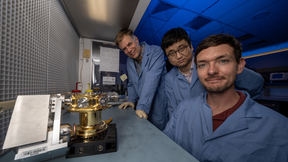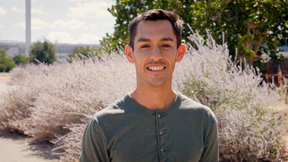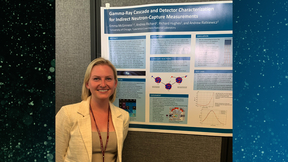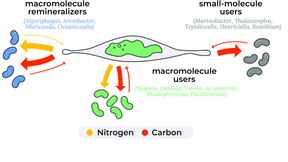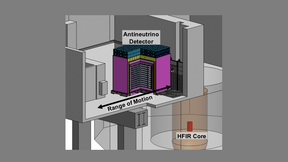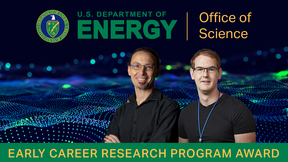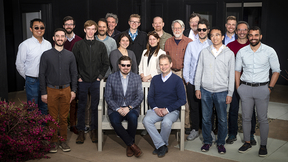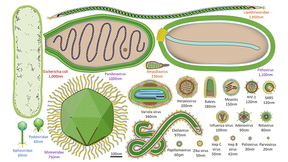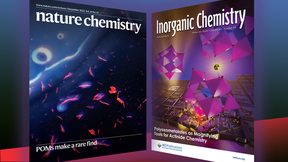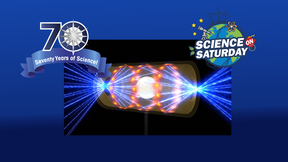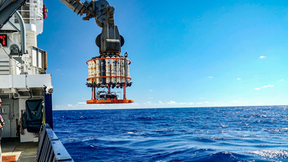Back
Nuclear and Chemical Sciences
Lab instrument now on two-billion-mile journey to the metallic asteroid Psyche
An instrument designed and built by Lawrence Livermore National Laboratory (LLNL) researchers departed Earth last week on a two-billion-mile, nearly six-year journey through space to explore a rare, largely metal asteroid. The Livermore high-purity germanium (HPGe) gamma-ray sensor is an essential part of a larger gamma-ray spectrometer (GRS) built in collaboration with…
All eyes on Miguel Cisneros
Miguel Cisneros is a first-generation Mexican American whose journey in life has taken him to explore and navigate the unknown fearlessly. Growing up, Cisneros was an only child who welcomed new adventures. His interest in exploring new experiences and places is something he continues to do to this day. Cisneros’ parents migrated from Mexico to the United States for a…
Two selected as Graduate Student Research program recipients
Two graduate students have earned Department of Energy (DOE) Office of Science Graduate Student Research (SCGSR) Program awards to perform their doctoral dissertation research at Lawrence Livermore National Laboratory (LLNL). The prestigious award helps cover living expenses and travel for 60 students from universities across the nation. Their proposed research projects…
Summer student work helps calculate neutron-capture reactions
Neutron-capture reactions on unstable nuclei play a key role in the production of heavy elements in the universe and provide vital diagnostics for reaction networks related to stockpile stewardship. However, these reactions cannot be measured directly because they involve radioactive nuclei. Lawrence Livermore researchers have performed indirect measurements to constrain…
Lawrence Livermore grabs two spots in DOE’s Energy Earthshot program
Lawrence Livermore National Laboratory (LLNL) scientists will lead and co-lead projects in support of the Department of Energy’s (DOE) new Energy Earthshot program. The Energy Earthshots Initiative calls for innovation and collaboration to tackle the toughest topics in energy-related research. In January, DOE announced Office of Science funding for the Energy Earthshot…
Not all bacteria are created equal
Lawrence Livermore National Laboratory (LLNL) scientists have found that bacteria can help algae make carbon-neutral biofuels or draw down additional carbon from the atmosphere if the conditions are just right. The team used LLNL’s nanoSIMS to understand and quantify the role of the algal microbiome in processing algal carbon (C) and nitrogen (N). The research appears in…
Unlocking gas phase uranium oxidation is key to nuclear debris modeling
In the quest to understand how nuclear debris forms, a team of scientists at Lawrence Livermore National Laboratory (LLNL) has developed an approach to studying the oxidation mechanism of gas phase uranium in extreme environments. In research recently published in Scientific Reports, the team outlined their work, which combined experimental data from a plasma flow reactor …
Measuring the antineutrino energy spectrum
Nuclear reactors, among the brightest terrestrial emitters of antineutrinos, have been central to neutrino physics. For more than a decade, physicists have puzzled over anomalous differences between measurements and predictions of the antineutrino emissions from nuclear reactors. These differences could reveal deficiencies in prediction methods and their underlying nuclear…
DOE honors two early-career Lab scientists
Two scientists from Lawrence Livermore National Laboratory (LLNL) are recipients of the Department of Energy’s (DOE) Office of Science Early Career Research Program award. Daniel Casey and Gauthier Deblonde are among 93 awardees receiving the recognition. Under the program, typical awards for DOE national laboratory staff are $500,000 per year for five years. “Supporting…
Sterile neutrino research ramps up
An international collaboration of researchers from Lawrence Livermore National Laboratory (LLNL) and other scientific institutions is ramping up its studies into “sterile neutrinos” to discover and better understand dark matter. Sterile neutrinos are theoretically predicted new particles that offer an intriguing possibility in the quest for understanding the dark matter in…
Cover cropping can increase farming yields
Cropland management practices that restore soil organic carbon (SOC) are often looked at as climate solutions that also enhance yields. But how often these benefits align at the farm level — the scale of farmers’ decision-making — remains unclear. In a new study in Nature Sustainability, a Lawrence Livermore National Laboratory (LLNL) scientist and collaborators examined…
Three graduate students earn awards to work at Lawrence Livermore
Three graduate students have earned Department of Energy Office of Science Graduate Student Research (SCGSR) Program awards to perform their doctoral dissertation research at Lawrence Livermore National Laboratory (LLNL). They are three among the 87 graduate students representing 33 states for the SCGSR program’s 2022 Solicitation 2 cycle. Through world-class training and…
Researchers explore how viruses enhance our understanding of life in the universe
On Earth, viruses are abundant and an integral part of life. However, very little is known about them outside human health contexts, especially in areas related to space. Understanding the role viruses play on Earth and how they interact with their hosts in extreme environments can better inform human spaceflight missions (environmental control, life support systems, and…
LLNL chemists double down with breakthrough method to study radioactive materials
Studying radioactive materials is notoriously difficult due to their radiation-induced toxicity and risk of contamination when handling. The cost of the radioactive isotopes used in research also is a major barrier, with some costing more than $10,000 per microgram. Certain radioisotopes also cannot be produced in sufficient quantity so it is simply impossible for…
Five Lab teams recognized with Secretary’s Honor Achievement Awards
Lawrence Livermore National Laboratory (LLNL) employees, participating in five project teams, recently earned Department of Energy (DOE) Secretary’s Honor Achievement Awards. Representing some of the highest internal, non-monetary recognition that DOE employees and contractors can receive, the Secretary’s Honor Awards recognize DOE employees and contractors for their…
Lawrence Livermore’s Science on Saturday lecture series moves to Las Positas College
Lawrence Livermore National Laboratory's (LLNL) popular lecture series, “Science on Saturday,” returns Feb. 4 and runs through Feb. 25. The new location of the lecture series is the Mertes Theater, Building 4000 at Las Positas College, 3000 Campus Hill Drive in Livermore. The series kicks off on Feb. 4 and offers four different lectures with the theme, “70 Years of Science…
Water modified ancient asteroid
Samples from asteroid Ryugu returned by the Hayabusa2 mission contain evidence of extensive alteration by water and appear related to CI chondrites, which are believed to best represent the bulk of the solar system composition. Lawrence Livermore National Laboratory (LLNL) scientists in collaboration with an international team looked at the isotopic composition of oxygen,…
LLNL Forensic Science Center team develops new technique to analyze fentanyl in blood and urine
A team of Lawrence Livermore National Laboratory (LLNL) scientists has developed a new technique to analyze fentanyl in human blood and urine samples that could aid work in the fields of medicine and chemical forensics. Led by Carlos Valdez, an LLNL synthetic chemist and lead author, the team discussed its new fentanyl analysis approach in a paper recently published in the…
New method unearths improved understanding of soil microbial interactions
Linking the identity of wild microbes with their physiological traits and environmental functions is a key aim for environmental microbiologists. Of the techniques that strive for this goal, Stable Isotope Probing — SIP — is considered the most effective for studying active microorganisms in natural settings. Lawrence Livermore National Laboratory (LLNL) scientists have…
Scientists use carbon to detect a new nitrogen source in the open ocean
Lawrence Livermore National Laboratory (LLNL) and UC Santa Cruz scientists have detected a previously hypothesized class of nitrogen fixation in the surface ocean. Nitrogen scarcity limits the growth of ocean phytoplankton, a globally important carbon sink and the base of the marine food web. Nitrogen that can be used by phytoplankton generally has a very low concentration…


